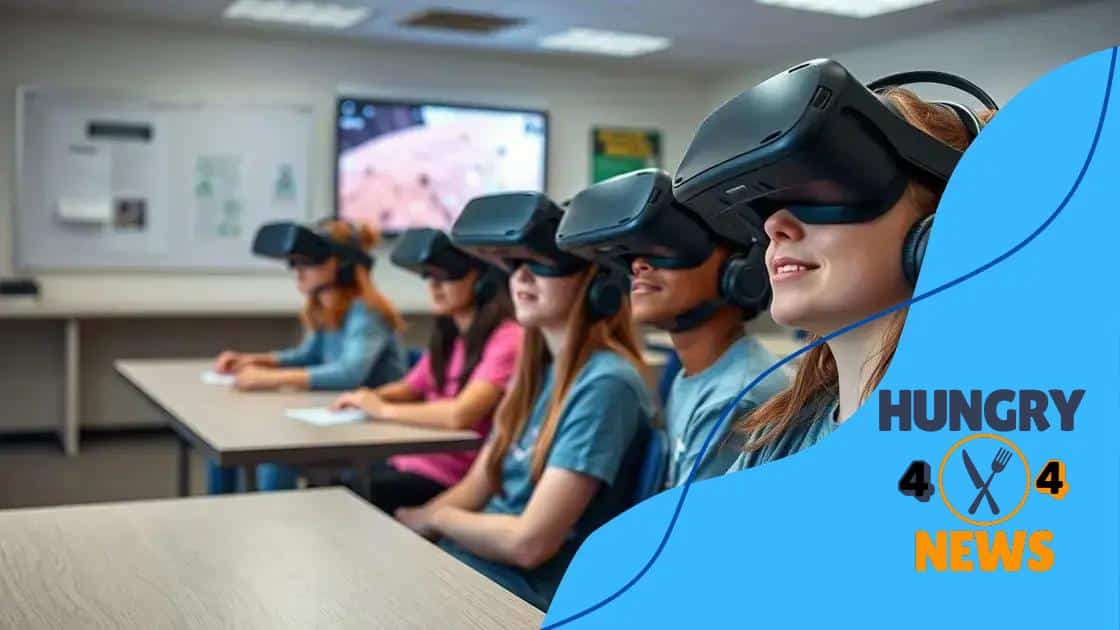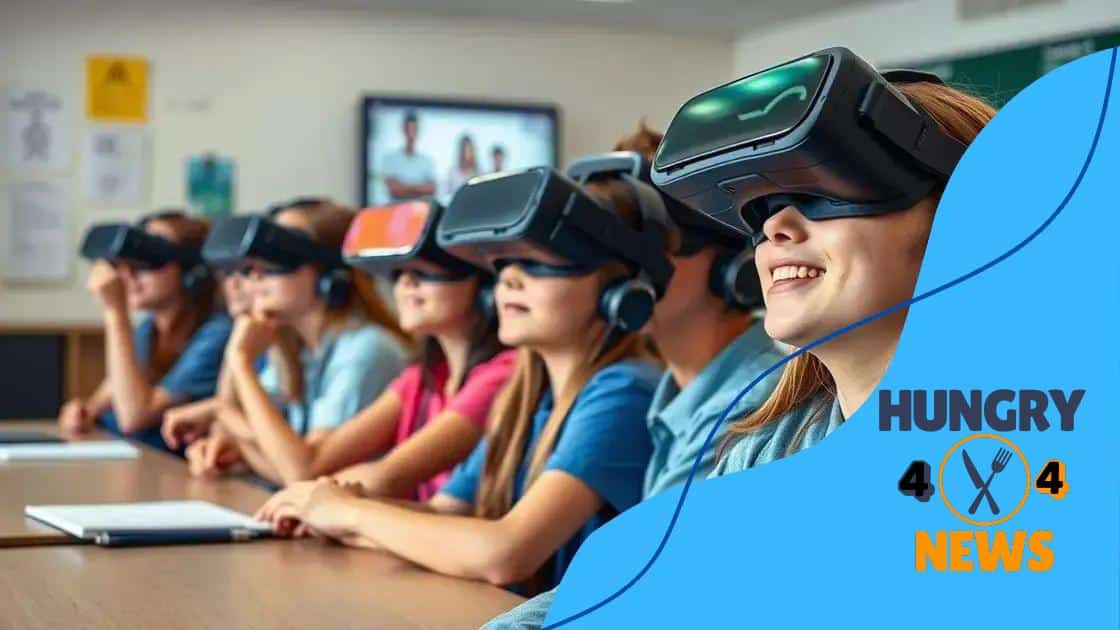Virtual reality applications in STEM education unlock creativity

Virtual reality applications in STEM education enhance engagement and understanding by providing immersive learning experiences that allow students to interact with complex concepts in a safe and controlled environment.
Virtual reality applications in STEM education are changing the landscape of how students learn and interact with complex concepts. Imagine students exploring the depths of the ocean or walking on Mars, all from their classroom. This technology sparks curiosity and enhances engagement.
Understanding virtual reality in education
Understanding virtual reality in education starts with grasping how this technology can reshape learning experiences. It allows students to immerse themselves in environments that are otherwise inaccessible, making complex subjects more relatable and engaging.
The immersive experience
One of the key benefits of virtual reality in education is the immersive experience. Students can participate in simulations that enhance their understanding of subjects like science and history. For example, they can witness significant events or explore ecosystems, providing a firsthand look at concepts.
This technology can significantly improve retention rates as students engage with the material in a new way. Instead of simply reading about an ecosystem, they can navigate through it and interact with virtual flora and fauna.
Benefits of virtual reality in the classroom
- Enhanced engagement: Students are more likely to pay attention and participate when using interactive tools.
- Real-world applications: VR allows learners to see how theories apply in real life, bridging the gap between the classroom and the world.
- Safe experimentation: Students can conduct experiments in a risk-free virtual environment.
- Diverse learning styles: VR caters to various learning preferences, accommodating visual, auditory, and kinesthetic learners.
Moreover, implementing virtual reality requires thoughtful integration into the curriculum, ensuring that it complements traditional teaching methods. Educators must assess how to use this tool effectively, considering factors such as content alignment and technical support.
As technology continues to develop, the potential of virtual reality in education seems limitless. Schools and educators are increasingly adopting VR, envisioning a future where learning becomes more intuitive and enjoyable.
Ultimately, understanding virtual reality in education is about recognizing its transformative promise. This technology not only enhances learning experiences but also prepares students for a digital future where innovation is key.
Enhancing hands-on learning with VR
Enhancing hands-on learning with VR technology is a game changer in education today. By allowing students to engage directly with their studies in immersive environments, this approach enables deeper understanding of complex topics.
Interactive learning environments
With virtual reality, classrooms transform into interactive learning environments. Students can step inside a human body to learn about anatomy or wander through ancient civilizations to see history come alive. This kind of engagement makes learning memorable and effective.
When students can actively participate and experiment, they tend to retain information better. For instance, performing a virtual lab experiment on chemical reactions can be more impactful than simply reading a textbook about it.
Benefits of hands-on VR learning
- Improved retention: Students remember information better when they can interact with it directly.
- Increased motivation: VR makes learning fun, increasing student motivation and enthusiasm.
- Skill development: Virtual simulations help students practice skills safely before applying them in real life.
- Individual pacing: Learners can engage with the material at their own pace, reinforcing their understanding.
Incorporating VR into hands-on learning not only captivates students but also caters to different learning styles. Visual learners thrive in immersive environments, while kinesthetic learners benefit from interactive experiences. These tailored educational strategies enhance the overall learning process.
Ultimately, the ability to simulate real-world experiences through virtual reality provides students with practical insights and essential skills for their future careers. As educators continue to explore VR tools, hands-on learning becomes more effective and accessible for all students.
Real-world applications of VR in STEM

Real-world applications of VR in STEM fields showcase how this technology can enhance learning and skill development. By simulating real environments, students gain practical experiences that are invaluable in their education.
Medical Training
In the medical field, virtual reality allows students to practice surgeries and medical procedures without the risk associated with real life. They can interact with 3D models of human anatomy, honing their skills in a controlled setting. This hands-on experience prepares them for real-world scenarios, improving confidence and competence.
Engineering Simulations
In engineering, VR provides tools for testing designs in a virtual space. Students can visualize complex structures and understand how different forces affect them. For instance, they can walk through architectural designs before they are built, addressing potential issues beforehand.
- Effective design visualization: Helps students understand the scope of projects.
- Risk-free testing: Students can experiment without physical limitations.
- Immediate feedback: Enables rapid prototyping and design adjustments.
Furthermore, VR applications in STEM extend to fields like environmental science, where students can study ecosystems or climate change impacts firsthand. By virtually traveling to different ecosystems, they can witness the effects of human actions on the environment in real-time.
Another area is astronomy, where students can explore the universe and understand celestial mechanics through immersive experiences. They can visit planets, view stars, and see how everything interacts within the cosmos, turning complex theories into vivid realities.
Integrating virtual reality into STEM education opens doors to innovative training and understanding. The immersive nature of VR ensures students not only learn theoretically but also gain practical experiences that prepare them for challenges in their future careers.
Feedback from educators on VR integration
Feedback from educators on VR integration in the classroom reveals a mix of excitement and challenges. Many teachers have quickly adopted this technology, recognizing its potential to engage students in learning.
Increased Student Engagement
Many educators report that using virtual reality has significantly increased student engagement. When students are immersed in VR experiences, they become more attentive and eager to participate. This high level of engagement often translates to better understanding and retention of the material.
Teachers have noticed that students are more curious and motivated to learn when using VR. This heightened interest can lead to deeper discussions and inquiries about the subjects being taught.
Challenges of Integration
While there are many benefits, some educators face challenges in integrating VR into their lessons. The cost of VR equipment and software can be a significant barrier for many schools. Additionally, teachers need training to effectively use these tools.
- Technical difficulties: Some teachers report issues with software or hardware that disrupts lessons.
- Time constraints: Finding time to incorporate VR into an already packed curriculum can be difficult.
- Support and training: Teachers often desire more support and professional development to effectively utilize VR.
Despite these challenges, many educators remain positive about the future of VR in education. They believe that as technology advances and becomes more affordable, more schools will be able to adopt these innovative teaching methods. Furthermore, sharing success stories among educators can inspire others to explore VR options.
By actively engaging students and making lessons more interactive, VR integration holds promise for transforming education into a more effective and enjoyable experience. With ongoing support and resources, teachers can overcome challenges and make the best use of this exciting technology.
Future trends in virtual reality and STEM
Future trends in virtual reality and STEM education are shaping how students learn and interact with the world. As technology advances, we can expect to see more innovations that enhance the educational experience.
Increased Accessibility
One major trend is the increasing accessibility of VR technology. As VR devices become more affordable, schools can integrate these tools into their classrooms more easily. This broad access means more students can benefit from immersive learning experiences.
Enhanced Customization
Another emerging trend is tailored educational experiences. With advancements in AI and machine learning, future VR applications will allow for personalized learning journeys. This means curricula that adapt to the individual needs of each student, enhancing their engagement and understanding.
- Progress tracking: Teachers will be able to monitor students’ progress in real-time, adjusting lessons based on their performance.
- Targeted resources: Students will receive materials that match their learning pace, making education more effective.
- Adaptive challenges: VR platforms will create challenges that change based on how well students are doing.
Moreover, collaborations between tech companies and educational institutions will increase. These partnerships will foster innovation in VR educational content, ensuring that resources are relevant and up-to-date with current industry standards.
As VR continues to evolve, we will also see improvements in content quality. The development of high-fidelity graphics and realistic simulations will provide even richer learning experiences. This will enable students to engage in scenarios that resemble real-world applications closely, like virtual labs or historical site explorations.
Finally, the trend towards social VR is on the rise. Students will be able to collaborate in virtual spaces, working together in science projects or coding tasks, regardless of their physical location. This social aspect can enhance teamwork skills and build a sense of community among learners.
FAQ – Frequently Asked Questions about Virtual Reality in STEM Education
How does virtual reality enhance student engagement in STEM?
Virtual reality immerses students in interactive environments, making learning more engaging and encouraging active participation.
What are some challenges of integrating VR in education?
Challenges include high costs, the need for teacher training, and technical issues that may disrupt lessons.
How can virtual reality technology be made more accessible to schools?
As VR technology becomes more affordable and user-friendly, schools can easily incorporate it into their classrooms.
What future trends can we expect in virtual reality for STEM education?
Expect personalized learning experiences, improved collaboration among students, and high-quality content that simulates real-world applications.





